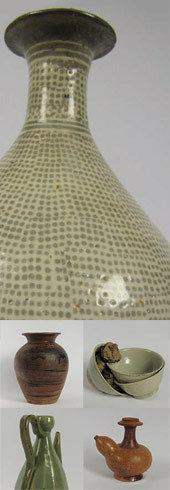Crossover
dal 25/10/2010 al 26/3/2011
Segnalato da
25/10/2010
Crossover
MAK Austrian Museum of Applied Arts / Contemporary Art, Wien
Two Collections - Private and Public. MAK Permanent Collection Asia. The exhibition 'Crossover' shows hundred works from Korea and the Siamese peninsula (today's Thailand) which were produced between the 6th and 17th centuries. Each collection complements the other, enabling new perspectives in the depiction of Asian art. This exhibition also acts as a reminder that most of the public collections were and are dedicated to the state by private collectors.

curated by Johannes Wieninger
MAK Curator Asia
The exhibition “Crossover” will show hundred works from Korea and the Siamese peninsula (today’s Thailand) which were produced between the 6th and 17th centuries. References to Chinese ceramics call attention to the international links.
If a European collects Asian works, he contributes to dismantling barriers between cultures. A collector decides to integrate his objets d’art, acquired over many years, into a public collection, the MAK collection. He thus transcends another border.
Jointly with objects from the MAK the exhibition presents a private collection which is specialized in East and South East Asia.
Each collection complements the other, enabling new perspectives in the depiction of Asian art. This exhibition also acts as a reminder that most of the public collections were and are dedicated to the state by private collectors. Korea developed its own school of making ceramics which boasted forms and glazes that were highly prized throughout Asia. Noteworthy during the period leading up to the 13th century is stoneware with celadon glaze, the olive-green color of which arises due to a reducing atmosphere firing process.
From then until the 16th century, so-called Buncheong ware—in which slip (a light, fluid clay mass) is used decoratively in various techniques— was dominant and had a great influence on the development of Japanese ceramics. Building on the high culture of the Khmer Kingdom with its capital of Angkor, the Thai people set up their own state beginning in the second half of the 13th century. The centers of ceramics production shifted to the region around Sukhothai and Si Satchanalai, 800 km northwest of Angkor, and to the Kingdom of Lanna.
The exhibition will be accompanied by a whole-room installation by Ursula Aichwalder. The artist clads the four tableaux in the exhibition space with the floating images Schokolade zerregnet, roter Saft, Nachtschatten and Durchblick. Visitors moving about the room will be treated to individual experiences of the interplay between materiality and shifting colors.
MAK Study Collection
In the Study Collection, the MAK exhibits selected objects of its extensive collection on a permanent basis. The arrangement by materials corresponds to the specializations of the collection’s curators, while the selection is based mainly on major lines of development. Temporary exhibitions offer an opportunity to cast a spotlight on various aspects of the collection and to consider objects in the collection between the poles of applied and contemporary art.
EXPERTS GUIDE with Johannes Wieninger, MAK Curator Asia Thu, November 25, 5.00 p.m.
MAK Press Office Monika Meryn (head of press office)
Olivia Harrer
Christiane Vogl
Phone (+43-1) 711 36-229 Fax (+43-1) 711 36-227 presse@MAK.at
Opening Tuesday, October 26, 11.00 a.m.
MAK
Stubenring 5, Wien
Opening hours Tue MAK NITE© 10.00 a.m.-12.00 p.m.
Wed-Sun 10.00 a.m.-6.00 p.m. Mon closed
ADMISSION
€ 9,90 including MAK Guide
€ 7,90 / reduced € 5,50
Free admission for children and teens up to 19, the unemployed and student groups accompanied by teachers.
Tour contribution € 2,00
Free admission on Saturdays©.



